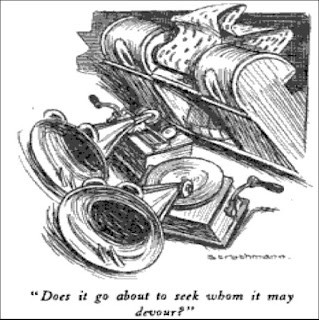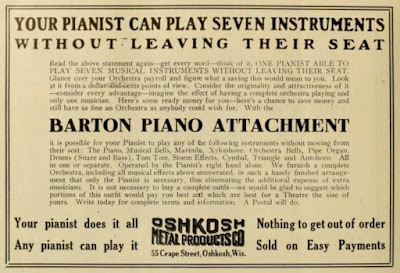Mechanical Instruments and Taylorized Musical Labor

In this cartoon from John Philip Sousa’s 1906 article, “The Menace of Mechanical Music,” two anthropomorphized phonographs and a push-up piano player with its large-toothed mouth agape charge forward while the piano roll trails behind in the wind. The machines have come alive; the phonographs’ hungry horns and push-up piano player’s inner mechanism threaten to gobble up the reader. Sousa’s article criticizes phonographs and player pianos alike, and he claimed it is “simply a question of time when the amateur disappears entirely, and with him a host of vocal and instrumental teachers, who will be without field or calling.”<1> With this article, Sousa touches upon an anxiety around technology and its influence on labor and production, a common anxiety in the early twentieth century and one many people still feel today.
To be sure, machines and their music influenced multiple areas of musical culture during and even before the machine age, from film scores to popular music and even the concert hall. At the same time, the mechanization of labor and the growing popularity of industrialized labor practices based on Frederick Winslow Taylor’s Principles of Scientific Management (1911) changed the musical marketplace and musical culture as a whole. As interest in mechanical devices that performed music — various models of player pianos, orchestrions, and mechanical bells — grew between 1900 and 1929 in the United States, the popularity of these mechanical instruments (along with music’s recorded alternative played via phonograph) gave rise to a new kind of musical labor, one that mirrored the ideals of efficiency, profits, and productivity prized in Taylor’s labor model. Consumers accepted music as something stored in a portable roll or record and issued from a machine and, as David Suisman put it, “music, which had once been produced in the home, by hand, was now something to be purchased.”<2>
Advertisements for mechanical instruments in magazines and motion picture trade papers illustrate the correlation between changes in labor culture and the rise of new musical machines. In The Audible Past, Jonathan Sterne shows how shifting ideas and developments in regards to areas such as colonialism, capitalism, and technological developments led to the cultural moment that prompted audio recording. Similarly, player piano ads give us a window into how changes in labor culture and new musical machines redefined music making, musical reproduction, and musical labor. The ads fall into two broad categories: those for player pianos in middle- and upper-class parlors, and those pushing mechanical instruments for motion picture houses. Each category encompasses different claims about the mechanical instrument’s value, including the instrument’s perfect musical reproduction and labor- and cost-saving capabilities for theaters, as well as the instrument’s appeal to crowds through mechanical novelty and spectacle. Analyzing the advertising strategies used to market these instruments uncovers a critical dimension to the anxieties around the nature of musical labor, and labor in general, in the first decades of the twentieth century.
But before I get into the nitty-gritty of a few advertisement examples, let’s talk about Taylorism, because Taylorized labor practices radically transformed the way in which many people worked, which in turn also influenced the ways people approached their lives outside of work. Taylor, a mechanical engineer known for his work on improving industrial efficiency, proposed a labor theory in which the end-result, production, took precedent over a rewarding labor process for the worker. Taylor’s system of scientific management breaks down labor into smaller tasks, essentially deskilling tasks to the level of unskilled or moderately skilled workers. The laborers function within a system, as part of a team of almost interchangeable workers. This model of mass production was the preferred method in factories by 1913-14, lasted throughout the First World War, and was still very much the norm for American factories during the 1920s, the machine age proper. In making the workplace more efficient, societal labor ideals shifted toward a system prizing rapid productivity, a system that rewarded workers for their ability to assume a place in the line and to increase production so that companies could produce and sell more and thus earn more money.
Mechanical instruments such as the player piano allow for a kind of deskilling of musical labor — the “skill” was programmed onto the piano roll. And though the deskilling of musical labor had a negative effect on the livelihood of many working musicians, the product helped bring much more music to people’s homes, alleviated the home-entertainment burden from many women, and lowered operation costs for motion picture houses by reducing the number of musicians required to accompany a film. In addition, player piano advertisers and salesmen promised families their mechanical instruments were “easy to play.”
This well-known example, one of a series of “Gulbransen baby” advertisements, claims, “a baby ‘invented’ the Gulbransen trade mark” when “years ago, a tiny year-old baby crept up, pressed a pedal, and gurgled gleefully when the Gulbransen played.”<3>
In selling mechanical instruments to motion picture houses, advertisers often emphasized the instruments’ practicality. In other words, selling the mechanical instrument to motion picture houses required less delicacy regarding labor reduction, perhaps because the labor saved is male labor, and perhaps because the dollars-and-cents of the theater as a business made such talk less crude.
For example, Creoma solo theatre orchestra-organs claimed to not require an operator at all thanks to their 134-note reproducing solo roll, saving motion picture houses the cost of hiring a musician.<4> Mechanical instruments reduced the amount of labor required, and therefore also saved money.
Other ads promised to provide additional features beyond the piano or organ, but without requiring an additional skilled musician to play them. For example, an advertisement for the Barton Piano Attachment promised that by using this attachment one pianist could play the piano, musical bells, marimba, xylophone, orchestra bells, pipe organ, drums (snare and bass), tom-tom, storm effects, cymbal, triangle, and autohorn — all with just his or her right hand.<5>
These advertisements for mechanical instruments for parlors and motion picture houses illustrate how changes in labor principles, especially due to the influence of Taylorism, fed into the changing musical marketplace of the early twentieth century. Whether marketing to parlors or picture houses, the bottom line of these advertisements was the same: manufacturers claimed the instruments reduced the amount of musical labor required to create a live musical performance. The early twentieth century’s Taylorized labor practices prized efficiency and productivity, and these practices softened the cultural mindset toward a reorganization, or mechanization, of life outside of work — a mechanization of art.
Although media changed from piano roll, to record, tape, CD, and Mp3, this time initiated drastic change in the reproduction, distribution, and consumption of recorded music. Early twentieth-century consumer demand for the musical commodity drowned out Sousa’s protests, rendering them imperceptible amid the rambunctious racket of mechanical instruments. And today, mechanically-consumed music is the norm as we stream music, often with little regard for artist compensation. Indeed, the reduction of musical labor due to mechanical recording and reproduction has only become more relevant with time as we enter an era in which we digitally stockpile more than a lifetime’s worth of music. Over a century later, examining the Taylorized historical context within which these cultural shifts began to take shape reveals much about the current attitude toward the value of musical labor in an age where quantization, auto tune, and digitization are the norm.
***
<1>John Philip Sousa, “The Menace of Mechanical Music,” Appleton’s Magazine 8 (1906): 280.
<2>David Suisman, Selling Sounds: The Commercial Revolution in American Music (Cambridge, MA: Harvard University Press, 2009), 10.
<3>The Saturday Evening Post (26 October, 1918): 25.
<4>Moving Picture World (21 July, 1917): 491.
<5>Moving Picture World (15 March, 1913): 1148.






